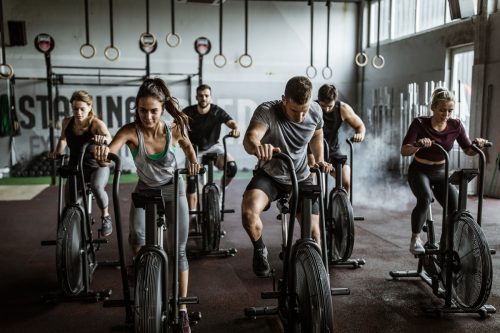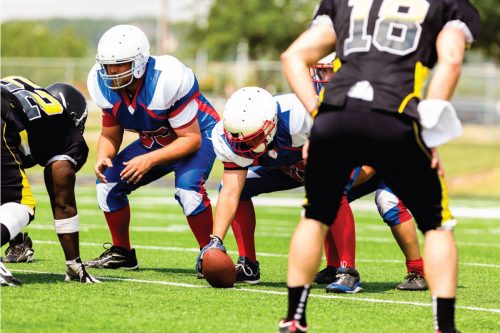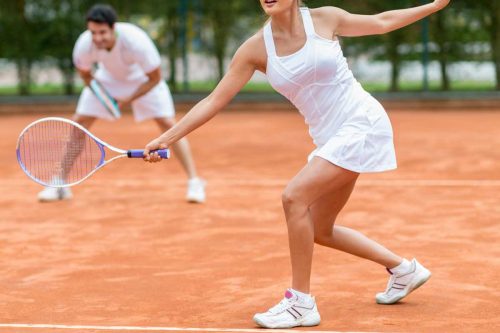You are wondering if basketball shoes should be tight on your feet. Given the constant cutting, running, and jumping required in basketball, this is a great question. We have done our research and cover how basketball shoes should fit.
Rather than fitting tight all around, the fit of basketball shoes is specific to the movement required in the sport. Basketball shoes should be relatively tight around the heel and ankles. Your toes, on the other hand, should have almost a thumbnail of space before the end, giving them plenty of room to move around. This combination is tight enough to provide ankle support and stability without restricting movement.
While this answer gives you a quick primer on how to size basketball shoes, we go into far more detail in the body of this post. Keep reading to learn why basketball shoes should be sized as discussed above, why the size is so important, and to get some tricks on finding the right size. We will even answer a few related questions.
![Basketball court floor with a ball and athletic shoes, Should Basketball Shoes Be Tight? [Important Fitting Tips!]](https://fitseer.com/wp-content/uploads/2020/10/Should-Basketball-Shoes-Be-Tight.jpg)
Why Basketball Shoe Fit Is Important
According to the University of Pittsburg Medical Center, the most common injuries in basketball are ankle and foot injuries. When you think about the movement required in basketball, this is no surprise. The constant cutting, jumping, and sudden changes of direction put a lot of stress on the ankles and feet. Click here to read the UPMC article on basketball injury.
While strength and conditioning are greats ways to reduce your chance of injury, proper support is equally critical. Getting the proper support requires making sure that your shoes fit correctly (and are designed for basketball). Shoes that are too big or too small can lead to small injuries such as blisters and toenail problems or more serious injuries such as ankle strain or break.
All in all, using basketball shoes that fit properly is the best way to protect your ankles and feet from injury, to stay comfortable on the court, and to maximize your balance and agility. Trusting the safety of your feet gives you the mental and physical energy to focus on the many other aspects of the game. This freedom not only improves your abilities as a player but reduces the chances of other non-ankle injuries.
How To Size Basketball Shoes
Due to basketball's popularity, many manufactures make shoes designed for the sport. Thus, finding shoes specific to basketball is relatively easy. However, before you choose your shoes, be sure to take the time to try on many different makes, models, and sizes.
It is recommended to try on many shoes because the specific proportions of each person's feet are unique. Read the specifics below to help find the perfect shoe for you.
Click here for a highly reviewed basketball shoe on Amazon.
Shoe Size
Everyone knows a size 10 means a slightly different thing for every make and model of shoe. So to find the right shoe, don't just automatically purchase your usual size. Instead, use your size as a starting point, combined with the advice below, and size up and down until you find something that fits your whole foot just right.
Ankle Fit
The area around the heel and ankle of the shoe should be the tightest place in the whole shoe. Tightness here helps the wearer cut laterally and to quickly change directions. On the other hand, looseness or sloppiness in the ankle/heel area can lead to injury.
When sizing the heel cup and ankle area for tightness, also be sure to take comfort into account. Ideally, you want a tightness that provides support without being uncomfortable.
Toe Fit
The toe box of your basketball shoes should be relatively unrestrictive or loose (especially compared to the ankle area). You want there to be ample room for your toes to spread out and move. Toe freedom of movement is critical for balance, quick cutting, and comfort.
As a general rule of thumb, leave about 1-2 centimeters (a thumbnail) between the end of your foot and the end of the shoe. However, it is possible to oversize your toe box, which can lead to blisters and a loss of mobility.
Main Foot Fit
The main foot should be sized between the tightness around your ankle and the looseness of your toe. That tightness should generally trend towards the ankle side. That is to say, if your ankle was tightness 4 and your toes are tightness 1, the rest of the foot should be around tightness 3. This provides ample support while simultaneously being comfortable.
Foot Expansion
Remember that your feet usually expand when they get hot and when you exercise. So expect your shoes to be tighter when you are seriously playing or practicing, as compared to when you are trying them on in the store. Keep this in mind or your run the risk of buying shoes that are too tight and, therefore, uncomfortable.
Player Style And Preference
Every basketball player is different. While the above categories and considerations are good rules of thumb, the only way to find the perfect shoe is to match the player and the player's style. For instance, a player more worried about ankle support might prefer high-tops while a player looking for ease of movement might prefer low-tops.
Low versus high-tops join breathability, stiffness, shape, and more in the long list of potential defining features. The best way to see if a shoe is right is to play-test it out. For new players, it might be tough to find the perfect shoe on the first try.
To increase your odds of success, follow the advice in this post and read up on current basketball shoe technology. It's also smart to think about your play style and position - forwards and centers need a more solid base and don't cut as often and usually prefer shoes with more support. Guards, on the other hand, tend to prefer shoes with more freedom of movement.
It is also helpful to consider your preference in other shoe types, especially sport shoes. If you prefer shoes of a certain tightness or degree of support in another sport such as football or volleyball, use that experience to help you choose basketball shoes.
How Do You Know If Basketball Shoes Fit?
The only way to be sure that a basketball shoe fits correctly is to try it out on the court. As this isn't an option before buying, first follow the advice outlined above. Another good practice is to "play-test" the shoes in the store. No sales clerk will begrudge you taking some cuts, jumping, running, and stopping with a pair of unpurchased shoes.
Overall, a basketball shoe fits correctly if it is comfortable, provides proper support, and allows you to move freely on the court. At the risk of repetition, accomplish this by trying on a ton of options!
Take a look at this YouTube video for some additional advice for fitting your shoes:
Do Basketball Shoes Stretch Out?
Like all shoes, basketball shoes do stretch out a little. However, the sturdy construction used to give your foot and ankle support means that the stretching is minimal. Do not count on your shoes to stretch as you wear them and buy shoes that fit correctly from the start.
Should Basketball Shoes Be A Size Bigger?
The short answer is no. The general rules about sizing basketball shoes outlined above are all you need. Do not buy shoes that are too big as that can lead to serious problems, injury, and discomfort. Use your usual size as a guide and try on shoes around that range.
If you are buying for a child you might want to err on the side of a little large to give them room to grow. However, you do not want to buy shoes that are way too big because this can greatly increase the risk of injury.
In Closing
Getting basketball shoes that fit properly is key to having fun and staying healthy out on the court. Take the time to get the shoes that provide proper support and comfort and they could last you for many seasons to come. Good luck!



![Read more about the article What Are The Best Socks For Pilates? [7 Suggestions]](https://fitseer.com/wp-content/uploads/2020/10/Woman-stretching-her-legs-and-limbs-on-a-yoga-mat-before-starting-stretching-500x333.jpg)



![Read more about the article At What Age Can You Start Surfing? [And At What Age Should You Stop?]](https://fitseer.com/wp-content/uploads/2020/11/A-surfer-wearing-a-white-shirt-and-aloha-pants-riding-the-waves-of-a-blue-ocean-500x333.jpg)